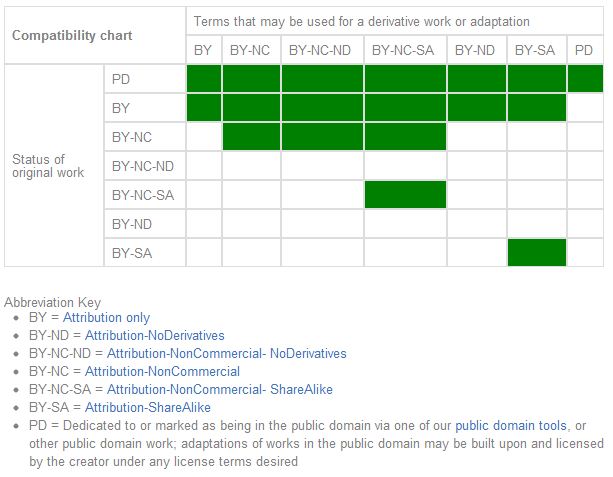Creative Commons
Creative Commons (CC) is a non-profit organization headquartered in Mountain View, California whose aim is to realize the full potential of the internet and drive a new era of development, growth, and productivity [1]. Essentially Creative Commons builds upon the already existing copyright protection which is applied to any kind of work immediately after it is conceptualized. Creative commons creates a free, public, and standardized infrastructure that creates a balance between the reality of the internet and the reality of copyright laws. Creative Commons provides an infrastructure which consists of a set of copyright licenses and tools that create a balance inside the traditional “all rights reserved” setting that copyright law creates. This done using a simple standardized way so artists can choose what level of copyright protection they desire. This ability plays a large roll on the Internet because information can be easily and legally, copied, distributed, edited and built upon.
Contents
- 1 History
- 2 Legal
- 3 License Types
- 3.1 The Three Layer Concept
- 3.2 Attribution license(abbreviated to 'BY')
- 3.3 Attribution Share Alike (abbreviated to ‘BY-SA’)
- 3.4 Attribution No Derivatives (abbreviated to ‘BY-ND’)
- 3.5 Attribution Non-commercial (abbreviated to ‘BY-NC’)
- 3.6 Attribution Non-commercial Share alike (‘BY-NC-SA’)
- 3.7 Attribution Non-commercial No Derivatives (‘bc-nc-nd’)
- 4 References
History
Creative Commons was founded in 2001 after receiving funding from the Center for the Public Domain [2]. By 2003 they had distributed 1 million licenses and as of 2009 that had licensed 350 million works and created their 3.0 version. [2]. Creative commons is intended to foster an infrastructure that supports creativity, sharing, and innovation by legally protecting materials that the original creators allowed enter into the public domain.
Name
Creative Commons is a common place for its users' information. The term commons is used because that is what the company set out to create; a common place where professional works can be accessed, and as the website says, "copied, distributed, edited, remixed, and built upon".
Legal
Ethical Issues
The most common criticism of the creative commons license is that the creativity of individuals can be exploited by others without investing as much time in creating original content. This idea lumps those using the creative commons license into the mindset of rehashing old work without contributing anything novel.
Because of the low amount of official administration under creative commons, many people can abuse works under its license by claiming others' work to be their own. Smaller groups of content production, like bloggers or small news publications, can be greatly affected by others taking their work under the Creative Commons license and reusing it.
License Types
The Three Layer Concept
[3] Creative Commons licenses are written in three "layers". This is done to make CC even easier to use. The first layer happens to be the legaleze that actually dictates the legal aspects of the license. Legal writing is often difficult and hard to read for most of the people that use Creative Commons so the company provides the second layer which is called the Commons Deed but is often referred to as the Human Readable version. This layer provides an easy way for the every day non-lawyer to understand what exactly the license allows for and covers. The third and final layer is the "machine readable" version. This allows for software and search engines to know what is available under a CC license.
Creative Commons offers six licenses for use and all of the licenses require attribution when using the work but don’t limit users ability to copy and distribute it.
Attribution license(abbreviated to 'BY')
You allow others to copy, distribute, display, and perform your copyrighted work - and derivative works based upon it - but only if they give you credit. [4]You allow others to distribute derivative works only under a license identical to the license that governs your work.
Attribution No Derivatives (abbreviated to ‘BY-ND’)
You let others copy, distribute, display and perform only verbatim copies of your work, but not derivative works based upon it.Attribution Non-commercial (abbreviated to ‘BY-NC’)
Is the attribution which dictates that the original work cannot be used for commercial purposes.Is similar to BY-SA, but with restriction that further uses can only be non-commercial.
Attribution Non-commercial No Derivatives (‘bc-nc-nd’)
Similar to BY-NC, but original material cannot be changed or adapted in any way. This license is the most restrictive of the six main licenses. The work cannot be used commercially, nor can it be altered in any manner. [5]

References
- ↑ About http://creativecommons.org/about accessed December 04 2011.
- ↑ 2.0 2.1 History http://creativecommons.org/about/history accessed November 28 2011.
- ↑ License Types http://creativecommons.org/licenses/ accessed November 5 2011.
- ↑ http://www.flickr.com/creativecommons/
- ↑ http://creativecommons.org/licenses/
